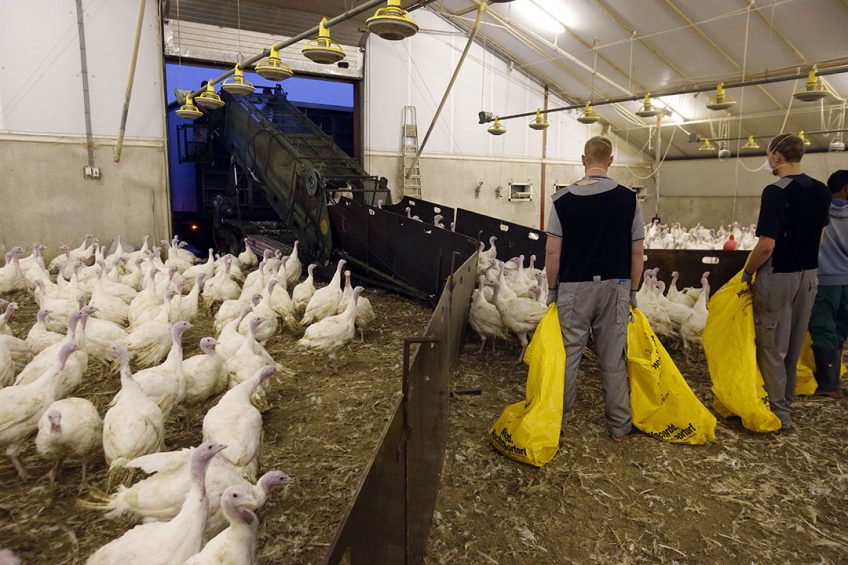Transporting turkeys in challenging conditions

Transporting poultry from farm to slaughterhouse is a challenging endeavour even in perfect conditions, and minimising bird stress is not only a boon for welfare, it means birds arrive with less liveweight shrink and other potentially detrimental effects on bird welfare.
The Turkey Science and Production Conference recently heard about Canadian research to help quantify the effects of temperature and humidity variations on turkeys during transport. Canada is a big country, and relatively few people live there. It is about 10m square kilometres and has a population of just 37 million people. In contrast, the United Kingdom manages to pack 66 million people onto a landmass of just 240,000 sq km. And most of the Canadian population live in the provinces of Ontario and Quebec.
Karen Schwean-Lardner, who is an assistant professor specialising in poultry management at the University of Saskatchewan, explains that the region in which she lives is even more sparsely populated. She told the Turkey Science and Production Conference that turkeys are produced in her province, but there are no processing facilities there, necessitating bird transport averaging up to 6-to-8 hours. “Turkeys have to be hauled either to Winnipeg or into Edmonton, and depending on where the farm is, it’s somewhere between 5-and-8 hours transport trip. It’s a long way.” Furthermore, the range of temperatures in the province is drastic. The coldest day recorded last year was -51.8°C, while the warmest temperature in the summer was 42.4°C. “We have a huge range in terms of temperature, and it is not unusual for us to move 20°C in one 24-hour time frame – it’s a bit of a challenge,” she explained.
Passive ventilation
“To further complicate the issue, North America still uses mostly passive ventilation trucks. Undoubtedly, this is a concern in terms of our welfare, and Canada is in the process of writing new codes of practice for transport. That brings us some interesting questions because we know very little about the transportation of turkeys, in terms of the science.” See continued: “Turkeys are not broilers, they have different responses, but if you don’t know what those responses are, it’s really hard to judge and to make regulations based on turkey transportation.”
Prof Schwean-Lardner explains that most work to date exploring transportation is based on broiler studies, which has prompted some of the papers she has co-authored in recent years. “We know that transporting in very cold temperatures can increase bird mortality. It takes huge mobilisations of energy for these birds to maintain some sort of thermal regulation, so we see drops in blood glucose and muscle glycogen as well because of cold transports.”
Excessive heat increases liveweight shrinkage, most likely due to dehydration panting. “You often see a high stress response and there can be higher mortality. So, there are problems on both ends of this spectrum when we talk to growers.” As a result, experiments were set up by the university to simulate the conditions turkeys face while being transported in both high and low temperatures. The procedures were all approved by the Canadian Council of Animal Care Guidelines and the university’s own animal care
Simulations
Environmental chambers were used in the experiment to simulate the conditions, as opposed to following turkeys in trucks as they travel through the countries “There are some disadvantages and some advantages to doing simulated transport work as compared to following trucks around the country site. The disadvantage is that the birds that were tested in this work did not have vibration [from transport], there was no air speed changes going on, the social dynamics are a little bit different, the noise levels are a little bit different, so it doesn’t give us a complete picture of what transportation itself might be. But, on the other hand, what it does do is let us look very carefully at things like temperature and humidity responses. Without all the other noise occurring.”
Data loggers were used in the environmental chambers, and loggers were administered to birds orally that sat in the crop or gizzard to give an indication of core body temperature. Feed was withdrawn four hours before slaughter and birds were weighed and blood sampled before and after the experiment, and videotaping took place to assess behaviour. Both hens and toms were assessed at three different temperatures; 20°C with 30% relative humidity (RH), 20°C with 80% RH and -18°C with uncontrolled RH. The warm transportation simulation saw turkey hens kept for eight hours at temperatures of 20°C or 35°C, and two levels of humidity 20% RH or 80% RH.
Also read: Maximising welfare in poultry transport
In the cold
The cold temperatures impacted bird physiology, with live shrink highest in those kept in -18°C conditions. Birds’ behaviour also changed to cope with colder temperatures, with huddling, shivering and piloerection all observed in the birds in the cold treatment.
Changes were also recorded in meat quality, with thigh PH higher for birds exposed to the cold treatment, and colour changes in both thigh and breast meat. Toms were less impacted by the cold temperatures, though at -18°C similar behavioural responses were observed, and thigh meat PH was also higher, as with the hens.
Warmer temperatures
The warmer temperatures proved a “significant” challenge for the toms in the enquiry, and those in the 30°C environment were removed from the study before the completion of the eight-hour experiment. Hens were not as significantly affected by the warmer temperatures, and Prof Schwean-Lardner said this was most likely down to the size difference of the birds. Behavioural changes observed included birds remaining still, resting heads against cooler parts of the crates or panting. In concluding, Prof Schwean-Lardner said cold temperatures resulted in a higher percentage of live shrink, darker meat and a tendency for core body temperature to decline. “Males appear more tolerant than females, and toms were severely impacted, and were removed from the experiment.” In contrast, hens coped better with the warmer temperatures.












